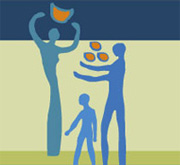
“ISO International Standards provide internationally recognized solutions to ensure quality, health, safety and economical production in the food sector, as well as simplifying business-to-business relationships in export trade,” comments ISO Secretary-General, Alan Bryden. “They also provide tools to implement regulatory requirements.”
The main focus within ISO of standards for the food sector is ISO/TC 34, Food products, which currently offers 717 standards and related documents. Its scope addresses standardization in the field of human and animal foodstuffs as well as animal and vegetable propagation materials, in particular terminology, sampling, methods of test and analysis, product specifications and requirements for packaging, storage and transportation.
Its work covers standards for practically all agricultural products for human consumption and animal feeding stuffs, whether directly or after processing, including seeds, fruit and vegetables, cereals, milk and milk products, meat, poultry, fish and eggs, spices, tea and coffee. About 65 % of its standards concern testing and analytical methods.
Among new areas addressed by ISO/TC 34 standards in recent years are the following:
- standards for the detection of genetically modified organisms and derived products in food;
- the ISO 22000 series of standards for safe food supply chains. An estimated 700 organizations in some 60 countries now have ISO 22000 food safety management systems;
- quantitative ingredient declarations (consumers want to know what they are eating);
- waste reduction by biotechnological methods and enhancement of the conversion of waste materials, manufacturing of new added value products.
Fifty-three countries participate in the work of ISO/TC 34 and another 53 have observer status. The main stakeholders directly concerned by its work are agricultural producers, food manufacturers, laboratories, merchants/retailers, consumers and regulators.
ISO has a strong partnership with many UN agencies concerned by food issues, including the World Health Organization (WHO) and Food Agricultural Organization (FAO), and the Codex Alimentarius Commission (CAC). ISO's observer status to the CAC provides an opportunity for the coordination of issues related to a variety of ISO standards that are adopted and used by Codex in its work.
With regard to analytical and test methods ISO/TC 34 and the International Dairy Federation (IDF) work together to prepare analytical methods that are published jointly.
More and more international standards, are referenced by regulators to provide a means of compliance with their technical regulations without creating unnecessary technical barriers to trade. This is recommended in the World Trade Organization's Committee on Technical Barriers to Trade (WTO TBT) and the WTO Committee on Sanitary and Phytosanitary Measures (SPS), in the context of implementing good regulatory practices. ISO has observer status on both committees. Using ISO International Standards also assists to achieve public health and safety policies at less cost to manufacturers and consumers.
- Food-related standards are also developed by ISO/TC 54, Essential oils, and by ISO/TC 93, Starch.
- Early this year, ISO created a new technical committee ISO/TC 234, Fisheries and aquaculture.
